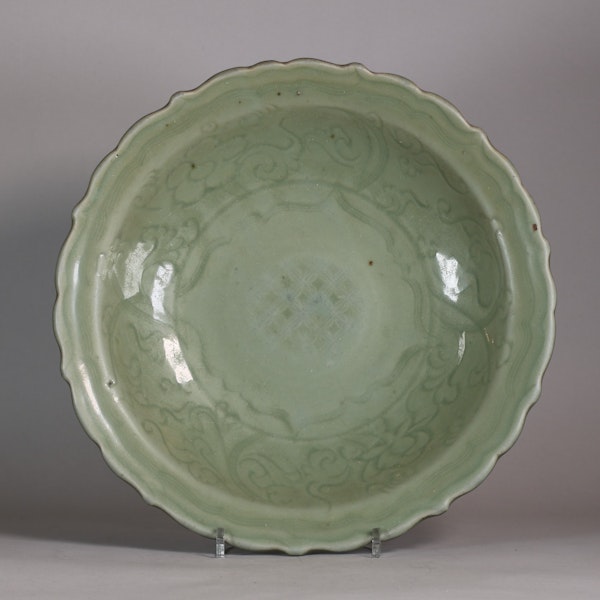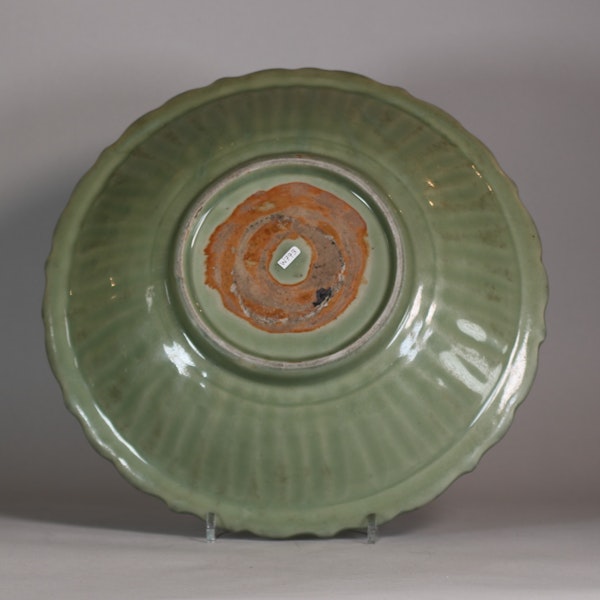A Longquan celadon-glazed shallow dish, Yuan or Ming Dynasty
A Longquan celadon-glazed shallow dish, Yuan or Ming Dynasty
POA
Description
A Longquan celadon-glazed shallow dish, Yuan or Ming Dynasty, with a flat barbed rim, decorated to the centre with an incised cash and trellis diaper pattern within an ogee-shaped roundel, the cavetto incised with a curling foliate scroll and flowerheads including lotus, all enclosed by a triple-line band to the rim, the sea-green glaze thinning to a paler tone at the edge, the reverse with gentle fluting and the base left partially unglazed for firing to reveal an ochre body.
Dimensions:
Diameter: 32cm. (12 1/2in.)
Condition:
Good, with usual wear
Notes:
First produced in China, celadons were highly prized for their resemblance to jade and the tranquil beauty of their glaze. They were exported across Southeast Asia and the Middle East long before European involvement in the trade of Asian ceramics.
The celadons of the Longquan kilns in Zhejiang province were among the finest produced in China, and the potters there led stylistic and technical developments in celadon production from the Song Dynasty (960-1279) through to the early Ming (1368-1644). The range of glaze colour from greyish to blueish greens results from the impact of variations in kiln temperature and atmosphere on the iron oxide within the glaze. The levels of iron oxide also have an impact on end colour; a lower iron oxide content will generally result in a blueish colour, while higher levels will result in darker, olive tones.
Under the so-called Pax Mongolia of the thirteenth and fourteenth centuries, trade with the Middle East flourished, aided by policies of Kublai Khan, who promoted the Silk Road network by introducing loans that financed trade caravans. Ceramics constituted an important part of trade, with wares from Jingdezhen and Longquan exported by Arab and Iranian merchants from Southern Chinese ports such as Guangzhou. Designs were adapted to suit the needs and preferences of consumers in the Middle East, where the custom of communal dining required larger dishes such as this celadon example.
A very similar Longquan dish, though slightly smaller and with a central Tibetan character, can be found in the collection of the Victoria and Albert Museum (C.89-1933).
A related dish (though without a flat barbed rim) in the collection of the British Museum (1963,0520.12) is engraved to the base with two marks in Arabic script giving an insight into the trade of Longquan celadon dishes to the Middle East: one inscription is a record of the weight of the dish in a Mughal Indian unit, the other reads ‘A’zam Khan’ and most likely refers to the initial owner.
Suggested reading:
Harrison-Hall, Jessica (2001) Catalogue of Late Yuan and Ming Ceramics in the British Museum (BMP: London)
Krahl, Regina; Erbahar, Nurdan; Ayers, John (1986) Chinese Ceramics in Topkapi Saray Museum, Istanbul: A Complete Catalogue Volume I (Sotheby’s: London)
| item details | |
|---|---|
| Material and Technique | Stoneware with celadon glaze and incised decoration |
| Origin | Chinese |
| Period | 15th Century and Earlier |
| Condition | Excellent |
| Diameter | 32cm. (12 1/2in.) |
Product REF: W773




